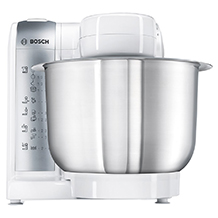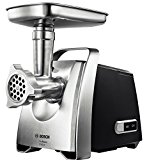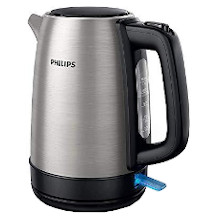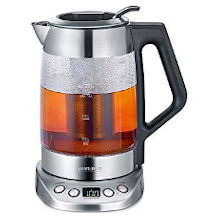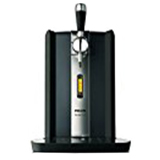Ice cream maker purchasing advice: how to choose the right product
- What You Need to Know
- With an ice cream maker, you can make fresh ice cream in all imaginable flavours at home.
- Models with a compressor are quick to use, but expensive. You can buy ice cream makers with a rechargeable battery at a lower price, but their pre-cooling time makes them less flexible.
- Preparation usually takes between 20 and 40 minutes. In the case of appliances without a compressor, you also have to allow for a lead time of 8 to 24 hours.
- The capacity is between 0.5 and 2.0 litres. The choice of size depends primarily on the number of people for whom you are making the ice cream.
- As far as the motor is concerned, the stronger the stirring power, the creamier the ice cream. It is usually between 100 and 300 watts.
- Ice cream makers with automatic shut-off, timer and cool-keeping function are particularly practical.
The ice cream parlour in your own home
As soon as the temperatures rise, long queues form in front of ice cream parlours. After all, there is nothing more refreshing than a delicious ice cream, especially in summer. If you don’t feel like waiting, the alternative is industrially produced ice cream from the supermarket. However, the taste of this cannot compete with the freshly prepared variety.
This is where an ice cream maker comes in. With it, you can conjure up ice cream creations in your own kitchen at any time of the day or night and enjoy them in a relaxed atmosphere on the balcony or in the garden. The homemade dessert is also sure to be a hit at children’s birthday parties, barbecues or other festivities. And when all the ice cream parlours are closed in the cold months, you can still indulge your ice cream cravings – for example with winter flavours from plum to cinnamon.

What are the advantages of an ice cream maker?
Still not sure whether the investment is worth it for you? Then let this advantage melt on your tongue: With an ice cream maker, you have full control over the ingredients list – so you know exactly which ingredients end up in your ice cream. If you do not use artificial flavourings, are lactose intolerant or sugar-free, you have maximum freedom of choice with your own ice cream machine when it comes to the composition of your cool treat. This means that health-conscious people, diabetics, allergy sufferers and vegans all get their money’s worth. What’s more, you can try out delicious flavours to suit your individual tastes: Whether you prefer the classics chocolate, vanilla and strawberry or more exotic directions – there are no limits to your creativity. So mix freely according to your taste, be it caramel and salt, peanut butter and jam or lemon and basil.
Are there alternatives to the ice cream maker?
Besides making ice cream in an ice cream maker, there are other ways to make ice cream. For example, you can mix the ingredients by hand, stir them and then put them in the freezer to freeze. However, this procedure is not only tedious but also laborious. Freezing is not enough to obtain creamy ice cream: You have to take the container out of the freezer every 20 to 30 minutes and stir the mixture vigorously. Otherwise it would crystallise and become hard. This is exactly what the ice cream maker does for you. Simply put the desired ingredients into the container. The appliance gradually adds air to this initial liquid by stirring it, while at the same time freezing the mixture. In this way, the ice cream not only becomes cold, but also creamy.
Ice cream over the course of time
It is true that the better society in China consumed a mixture of snow, fruit, honey and rose water from time to time as early as three thousand years before Christ. However, the first ice cream was created around 1530 in Sicily, where it is also known as gelato. In 1843, the first ice cream machine was invented in the USA, which at that time was still hand-operated. is not enough to freeze it. However, they did not become widespread on the European market until the beginning of the 20th century.
The way it works: Different types of refrigeration
There are two different cooling principles for ice machines: Models without and those with a compressor. The former rely on cooling packs that have to be brought to the right temperature in the freezer beforehand. The latter actively cool down the contents. Which method you choose depends, among other things, on your budget and how much space you have in the freezer compartment. While the cheaper, more manageable ice cream machines without a compressor are sufficient for occasional ice cream enjoyment, it is well worthwhile for ambitious hobby chefs with a spacious kitchen to purchase the higher-priced version with a compressor.
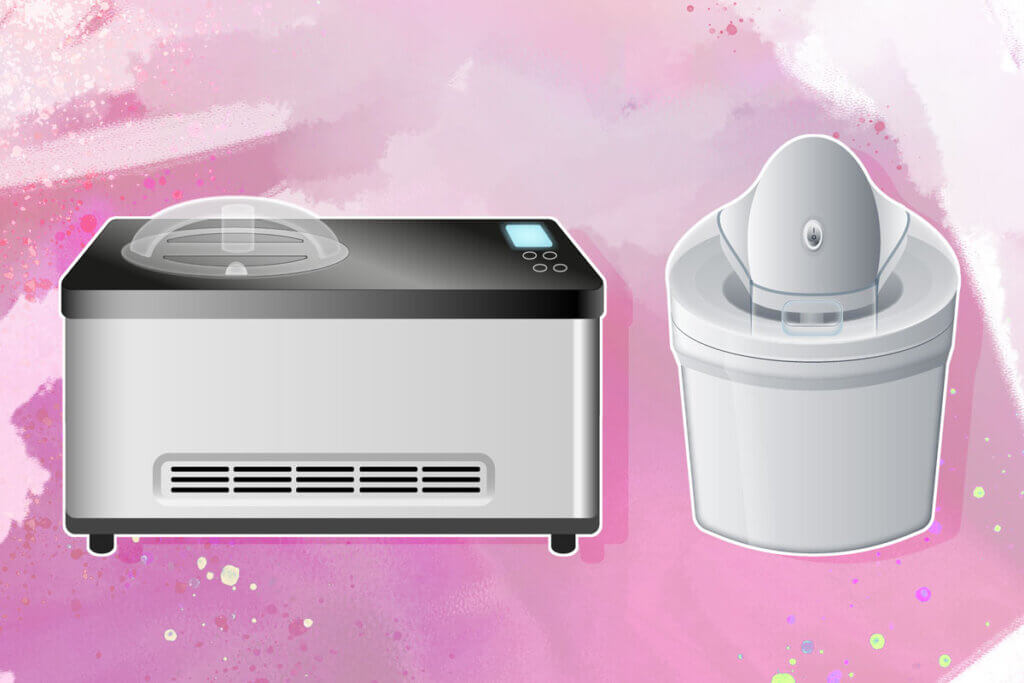
Ice cream machines without compressor: For occasional gourmets
Compressorless ice cream machines have a removable cooling battery. The models with passive cooling are considerably cheaper than their counterparts with a compressor. Their purchase costs start at around 30 euros. In return, however, they require much more time. After all, users have to put the battery in the freezer for 8 to 24 hours before use, as these ice cream machines cannot cool the mass on their own. They then place the cooling unit in the machine, where it releases its cold into the mass. This means that they have to know the day before that they want to eat ice cream the next day – spontaneity is out of the question.
In addition to a certain lead time, users also need sufficient space in the ice compartment. Another disadvantage: the battery heats up during operation, so it gradually loses cooling capacity. On the one hand, there is a risk that the ice cream will fail. On the other hand, the devices cannot be used again immediately, for example for another type of ice cream. However, their handy size and light weight are an advantage. This makes them easy to store or transport. In addition, these ice cream machines are much quieter and consume less electricity than models with a compressor.
Pro points
- Inexpensive to buy
- Compact and light
- Quiet operation
- Low power consumption
Drawbacks
- Long preparation time
- A lot of freezer space required
- Sometimes fails because of heating
- No continuous operation possible
Who are these models suitable for?
Ice cream makers without a compressor are ideal for sporadic use. So if you only want to make ice cream now and then and have a small budget, but a large freezer compartment and patience, an ice cream maker without a compressor will suffice.
Tip
If you have enough space in the freezer compartment, you can store the ice pack there continuously and thus indulge your ice cream cravings a little more flexibly.
Ice cream machines with compressor: For spontaneous ice cream cravings and gourmets
The higher-priced ice cream machines with compressor usually cost between 50 and 200 euros; professional machines sometimes cost well over 1,000 euros. But these self-chilling models require neither a long preparation time nor space in the freezer. Their mode of operation is comparable to a refrigerator: The compressor actively extracts heat from the mass. In this way, it cools it down quickly and evenly – to a temperature between minus 18 and minus 38 degrees Celsius, depending on the model. At the same time, a stirring arm constantly mixes the frozen ingredients with the warmer ingredients, which in turn ensures a creamier consistency. With top models, ice preparation takes only about 30 to 60 minutes. Moreover, ice cream machines with an integrated compressor are ready for use again immediately after cleaning, so they can make several ice cream creations in a row.
A disadvantage is the higher power consumption of the self-cooling appliances. In addition, due to the built-in technology, they are not only relatively large (about the size of a microwave) and heavy (up to 15 kilograms), but also loud (about the volume of a hoover). Although users do not need a large freezer compartment, they should plan a fixed place in their kitchen where they can place the appliance so that it does not interfere. However, many consumers are happy to accept this drawback in order to be able to make ice cream spontaneously and conveniently.
Pro points
- Ready for use without pre-cooling
- Quick preparation
- Continuous operation possible
- Creamier consistency
Drawbacks
Expensive to buy
High power consumption
Large and bulky
Loud in operation
Who are these models suitable for?
Ice cream machines with a compressor are ideal for anyone who likes to experiment when making ice cream, has frequent guests, attaches great importance to a creamy consistency and would invest a lot of money accordingly.
What matters when buying
Ideally, an ice cream maker should be easy and convenient to use and produce high-quality ice cream. However, to find the ideal machine for your needs, there are a lot of other factors to consider when making your purchase decision. Depending on whether you are a beginner or professional, occasional or frequent user, single or large family, you should weigh up criteria such as capacity, performance and preparation time, the material as well as the variety of functions and accessories.
Capacity, dimensions and weight
The capacity determines the amount of ice cream you can make in one run. The choice depends on how many portions you want to prepare at the same time. So it depends on whether you want to make ice cream mainly for yourself, for your family or also for guests:
- While a filling volume of up to about 0.5 litres is only suitable for smaller portions, i.e. for one or two people,
- and a capacity of around 1.0 litre is sufficient for three to four people,
- a capacity of between 1.5 and 2.0 litres is required for feeding larger families or guests.
The smaller versions are ideal for single and couple households as well as those looking for a compact, space-saving appliance. Versions with a compressor usually have more filling volume and are thus a lot bulkier than models with a cooling battery. They are usually about 30 to 40 centimetres deep. Ice machines without a compressor are often only half the size. The compressor also adds a lot of weight, which is why these machines weigh an average of 10 to 15 kilograms. So you should think carefully in advance about whether you have enough space in your kitchen, pantry or cellar.
Maximum capacity versus maximum filling quantity
Bear in mind that the maximum capacity of the ingredients you put in the ice cream container is less than the actual capacity. This is because the amount of ice cream produced will end up being greater than the raw mixture. So fill the mixing bowl no more than two-thirds full. Example: There is room for 1.0 litre of raw mass in the 1.6 litre freezer container of the Krups Perfect Mix 9000.
Motor power and noise level
The motor of an ice cream maker is responsible for the mixing mechanism on the one hand and for cooling on the other. Its performance is therefore crucial for the consistency of the ice cream mass. After all, only a powerful model ensures that the mass freezes evenly and that no crystals form. Inexpensive models with a passive cooling unit usually have a power output of only 6 to 20 watts; high-quality ice cream makers with a compressor, on the other hand, have a power output of between 100 and 300 watts, which allows them to reach a temperature of minus 35 degrees Celsius in the shortest possible time.
Directly related to the power is the noise level during operation. Self-cooling appliances in particular can reach high volumes of up to 70 decibels. The noise level can be roughly compared to the volume of a hoover. Mid-range products produce a noise level of about 60 to 65 decibels and particularly quiet models are limited to a maximum of 55 decibels. Models with a cooling battery are generally quieter because they only work with an agitator.
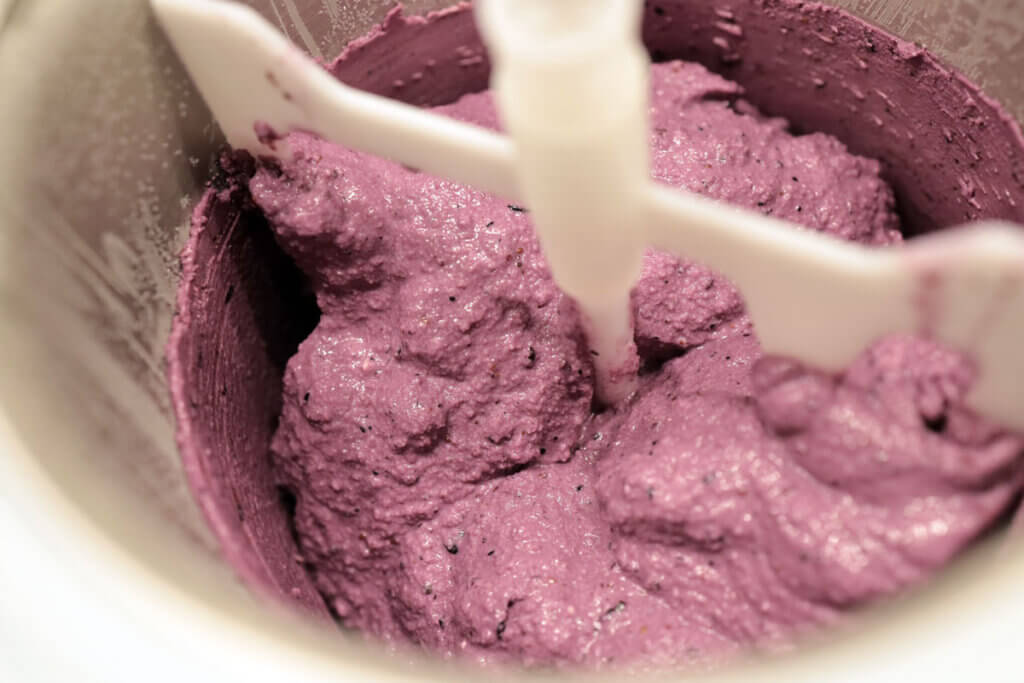
How long does it take to prepare ice cream with an ice cream maker?
The type of cooling does not play a major role in the preparation time itself, i.e. the time from filling the ingredients to the finished ice cream. Instead, it varies depending on the model, quantity and starting temperature: While it is between 20 and 40 minutes for appliances with high-quality cooling, it is not uncommon for you to have to wait 90 to 120 minutes for other versions before you can enjoy the ice cream. For appliances without a compressor, the pre-cooling time (between 8 and 24 hours) must also be taken into account. The time you save with a high-quality model is particularly noticeable if you make ice cream regularly.
With top models, the preparation time can be adjusted individually with the help of a timer function, i.e. to the minute or in 10-minute steps, so that you do not have to keep an eye on the production process. Accordingly, smaller amounts of ice cream are ready in only 10 to 20 minutes, whereas larger portions are only ready to eat in an hour. The control is either via a display or a rotary wheel. In the Emma from Springlane, for example, the cooling time is set to 60 minutes by default. However, it can be readjusted via two additional buttons, a plus and a minus button.
Tip: If the finished ice cream is not yet firm enough, simply place it briefly in the freezer again.
Don’t forget
Allow time for the preparation of the ingredients. If you chill them sufficiently beforehand, you will shorten the preparation time.
What material is an ice cream maker made of?
The housing of an ice cream maker is either made of plastic, stainless steel or a combination of materials. In the latter case, manufacturers usually use synthetic material for the exterior, i.e. the housing, and stainless steel for the interior, i.e. the ice container and ideally also the stirrer. While synthetic material weighs little and is easy to clean, stainless steel scores with its robustness and durability. A machine made of stainless steel usually looks simpler, but also of higher quality. Models with a neutral look can be easily integrated into any kitchen. With plastic cladding, on the other hand, more colourful designs are possible, making the ice cream machine a real eye-catcher. Whether it’s the retro look or classic white, there are now appliances to suit every taste or interior style.
Lid and stand
Lids made of transparent plastic not only protect against splashes but also allow a view inside: Users can see the progress of the freezing process at any time. If there is also an opening or flap in the lid, they can add ingredients such as nuts, fruit or chocolate chips, which are only to be added after the cooling process, even during the blending process.
Rubberised non-slip feet also ensure that the ice cream maker always stays in place during operation.
Functions and programmes
For convenient, uncomplicated operation, a clear display is helpful, among other things, on which you can read the remaining preparation time and the temperature. It also shows the mode, for example “cooling” or “stirring”. Automatic programmes automatically recognise the progress of the ice cream and inform the user with an acoustic signal as soon as the perfect result has been achieved. This means you do not have to check the consistency of the ice cream mass by visual inspection, but can rely on the monitoring display, usually an LC display. Models with sensor automation even check the consistency during operation and adjust the remaining time as needed.
If you want to make different ice cream specialities, i.e. sorbet or frozen yoghurt in addition to conventional ice cream, you should make sure that the ice cream machine has a wide freezing range. Different temperatures are needed to achieve the right consistency. Frozen yoghurt, for example, tends to be soft, while sorbet tends to be hard. The following applies here: the larger the freezing range, the wider the range of applications. A digital temperature display makes it possible to monitor the cooling process.
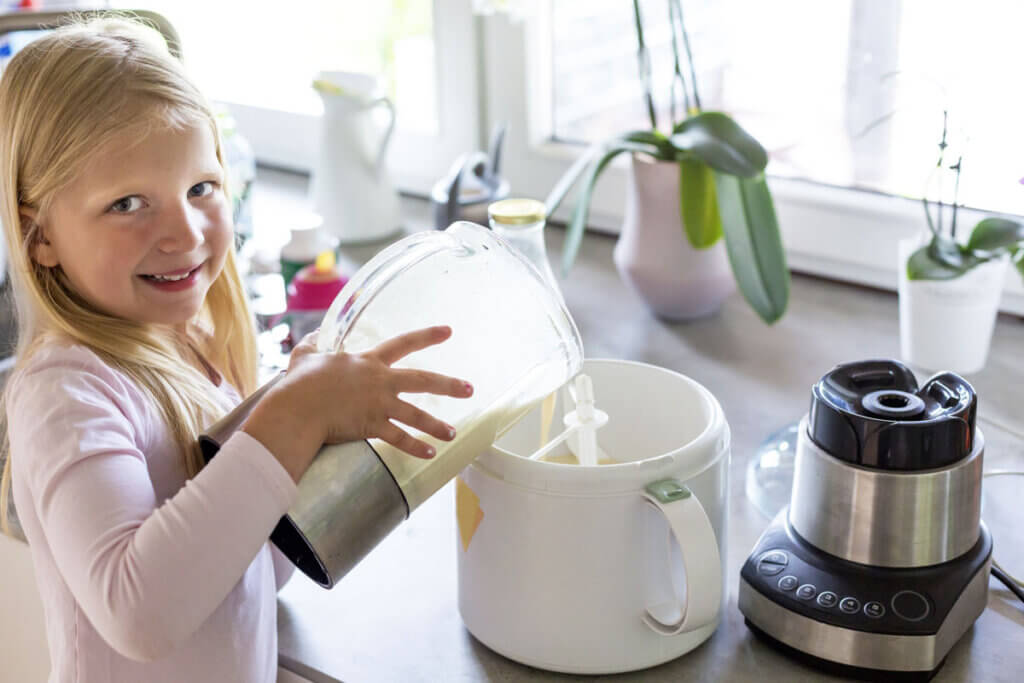
In contrast to models with a simple on/off switch, appliances with an automatic switch-off function stop operating automatically when the timer or programme has run out. This is followed by the safety lock, i.e. the childproof lock. With some appliances, it is also possible to interrupt the process and continue it at a later time. A keep-cool function allows the finished ice cream to be kept cold for a while – up to six hours after preparation, depending on the model – for example at a party. This practical function also prevents the ice from melting when the signal sounds but you are not around at the time.
Practical accessories
Many ice cream machines come with accessories. These include, for example, a measuring cup for measuring the liquids, an ice cream spoon for convenient and even portioning and a silicone ice cream scraper. The latter can be used to mix the mixture and to remove the finished ice cream from the cooling container without leaving scratches. An additional freezer container is also practical for preparing different types of ice cream at the same time. A recipe book provides you with creative ice cream ideas so you can get started straight away.
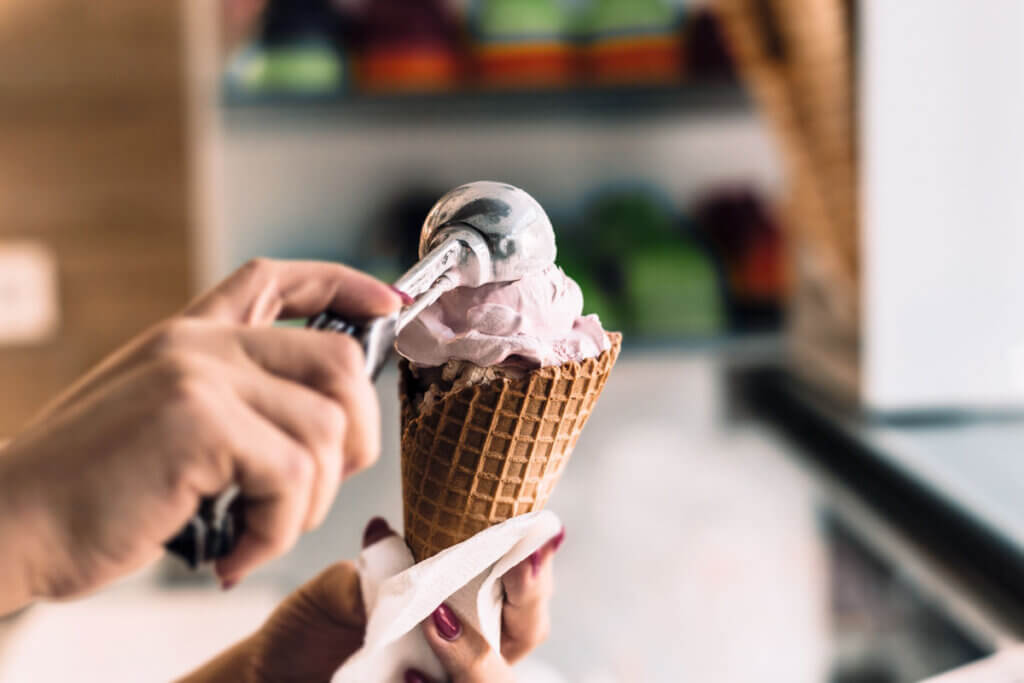
If you want to serve homemade ice cream like in a café, you might also be interested in the following accessories:
- Ice cream cups and spoons
- Cream piping bag
- Ice cream wafers, sprinkles and sauces
Ice cream variations depending on the production method
In addition to classic ice cream, an ice cream machine can usually be used to prepare other ice cream variations whose production process differs from that for normal ice cream:
Sorbet
Fruit ice cream is the oldest variation. It is made by stirring juice, syrup or frozen fruit quickly. Fresh fruit must be pureed in advance, as an ordinary ice cream machine is not capable of doing this. Special sorbet machines do this automatically and even have a tap for portioning.
Parfait
To make parfait, you need to whisk egg yolks and sugar in a bain-marie, then add cream and other desired ingredients. The machine then processes the ingredients into a creamy mass.
Gelato
This Italian classic contains more milk, less cream and no eggs than traditional ice cream. Its consistency is denser and softer at the same time.
Frozen Yogurt
This ice cream made from natural yoghurt scores with its low fat and sugar content. Depending on your taste, you can refine the finished ice cream with fruit, sugar or vanilla.
Soft ice cream
Soft ice cream is basically ice cream whose mass is cooled down to minus 6 degrees Celsius instead of minus 12 degrees Celsius and whipped to a creamy consistency with compressed air. This creates the characteristic soft consistency. For fans of this ice cream, a soft ice cream machine may be worthwhile. With the help of a tap, the ice cream can be portioned directly into a bowl or onto a wafer.
Slush Ice
These semi-frozen drinks consist of fruit juices, lemonades or coffee or tea, and often a mixture of syrup, flavourings and colourings. They are therefore naturally dairy-free. Their sometimes bright colours make them a real eye-catcher. Slush ice machines crush the ice cream and mix it with the chosen flavouring to create a homogeneous mass.
When Germans dream of Italy
With a spaghetti ice cream machine, you can shape already finished ice cream, usually vanilla ice cream, into a spaghetti-like form. To do this, you simply press the ice cream through a kind of sieve. Then garnish it with strawberry sauce (as a replica for tomato sauce) and nut “parmesan”.
Classic ice cream
Traditional ice cream consists of milk, cream, sugar and egg yolks. If you prefer vegan ice cream, you can easily replace animal milk with plant-based alternatives such as soy, almond or coconut milk. Instead of egg yolk, use locust bean gum as a binding agent.
Recipe for delicious strawberry ice cream
For a classic strawberry ice cream you need the following ingredients:
- Strawberries
- Sugar
- Cream
- Milk
- Eggs
- Lemon juice
- Vanilla extract
- Salt
Puree the strawberries as finely as possible, then mix the puree with the other ingredients – and off into the ice cream maker.
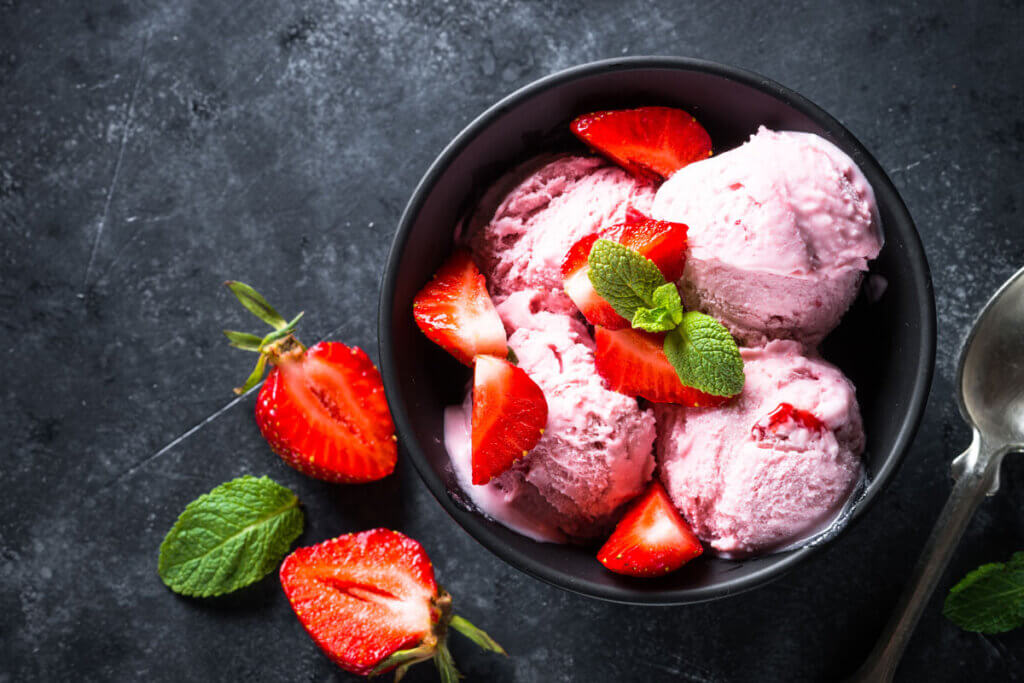
Shelf life and cleaning
The shelf life of your ice cream creation depends on the ingredients used. However, there are usually no preservatives and bacteria such as salmonella can survive in the freezer. Therefore, you should not store varieties prepared with fresh eggs for more than three days. Also, do not refreeze it after defrosting. If the ice cream is made of fresh fruit and milk, you should store it for a maximum of six days, as the fruit acid causes the milk to spoil quickly. It is also important for the taste and consistency that no ice crystals form. So always pack the ice cream airtight and do not leave the ice cream container at room temperature for too long.
Most ingredients used to make ice cream provide an ideal breeding ground for health-threatening bacteria, germs and mould. To ensure perfect hygiene at all times, it is therefore essential to clean the ice maker carefully on a regular basis, ideally directly after each use. Cleaning is easiest if the appliance can be dismantled into individual parts and these are dishwasher-safe. This usually applies to all parts that come into contact with food, i.e. the lid, the mixing arm and the container. If these parts are not suitable for the dishwasher, you should at least be able to remove them easily to wash them under running water. However, never use an aggressive detergent, which could damage the components. Hot water and, if necessary, a mild detergent will suffice. Dry all components thoroughly before putting them back together.
After cleaning the individual parts, it is time to clean the seals and the housing manually – after all, splashes can get on the outside of the ice cream maker when you pour in the ingredients. The easiest way to do this is with a damp sponge or cloth. Be extremely careful with stainless steel surfaces, however, as they scratch easily. And make sure that no water gets into the motor compartment. To be on the safe side, pull out the plug before cleaning.
Well-known brands
Springlane | Krups | Klarstein | UNOLD | WMF | De’Longhi

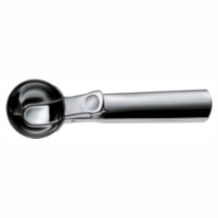
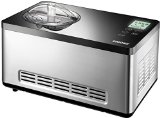
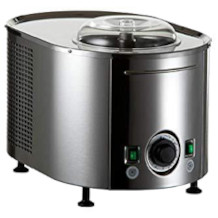

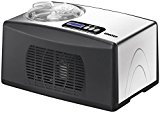
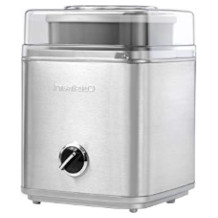
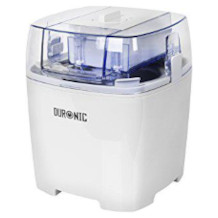
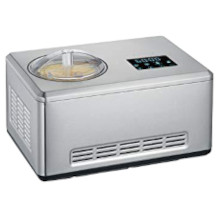
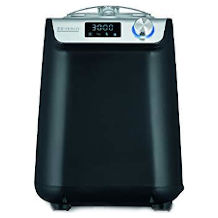
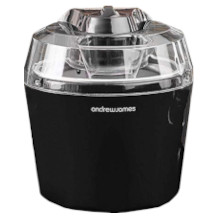
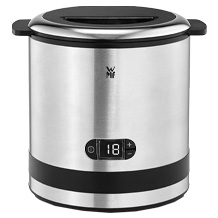
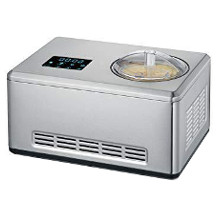
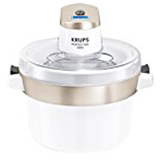
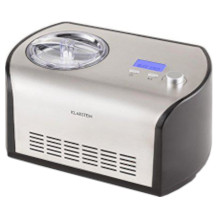
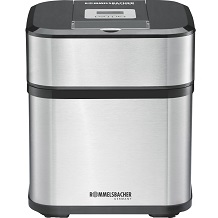
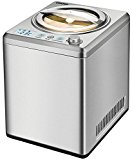
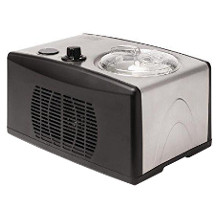
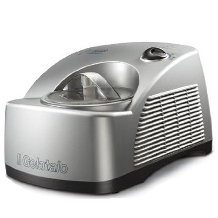
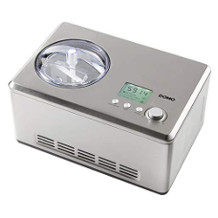
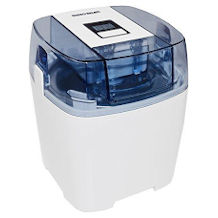
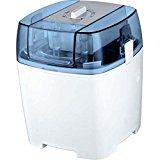
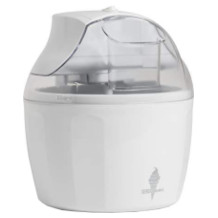
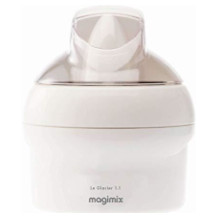

 600 reviews
600 reviews
